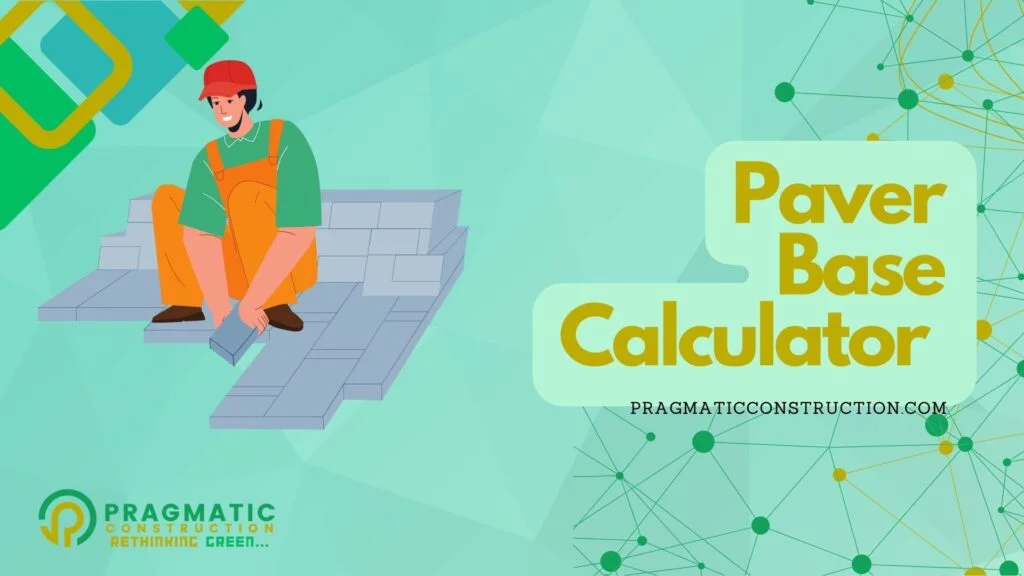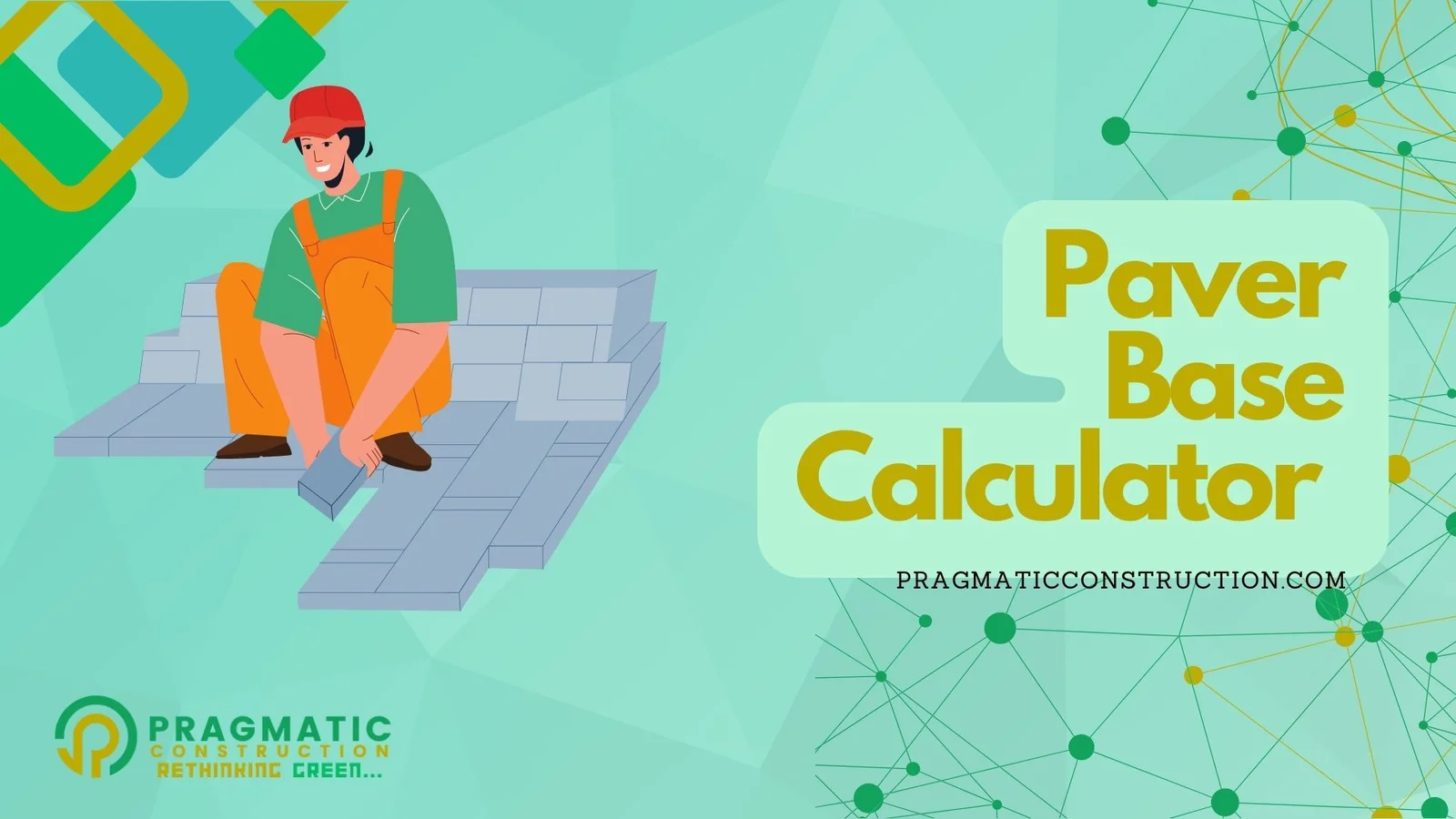Pavers have become a popular choice for landscaping projects due to their durability, versatility, and aesthetic appeal.
Whether you’re creating a patio, walkway, or driveway, installing pavers requires careful planning, especially when it comes to the base.
In this guide, we’ll delve into the importance of a solid paver base and introduce the concept of a paver base calculator, specifically focusing on the Paver Base calculator.
- Importance of a Solid Paver Base
- Calculating Material Requirements
- Summary of Steps to Calculate the Base Material required for pavers
- Sand Base Computation
- Paver Base Calculator
- How deep should be the base for pavers?
- Avoid Using Plastic Under Paving Applications
- Considering the Base
- Paver Stone Dimensions
- Tips for Using the Calculator
- Proper Base Material Handling
- Conclusion

Importance of a Solid Paver Base
Before laying pavers, it’s crucial to establish a solid base to ensure long-term stability and prevent issues such as sinking, shifting, and uneven surfaces.
The depth of the base varies depending on the intended use and the characteristics of the subsoil.
For instance, a minimum of 4 inches is recommended for patios and walkways, while driveways may require 8 to 12 inches of base.
In areas with heavy clay soil, the base depth may need to be increased to 18 inches or more to accommodate proper drainage and support the weight of vehicles.
Calculating Material Requirements
The paver base, composed of gravel, provides a stable foundation for the project while ensuring proper drainage.
For a patio or walkway, the paver base should be compacted to a depth of 6 inches.
The formula below incorporates compaction:
(length of project in inches) x (width of project in inches) x [(depth of base material in inches) + (20% of the depth of base material in inches)] ÷ 1728 = cubic feet of base material
Using this formula, for example: 144 in x 96 in x [6 in + (6 in x 0.20)] ÷ 1728 = 57.60 cu ft
Interlocking paver base panels offer an alternative to gravel bases. They are lightweight, requiring less sand and excavation.
Please note that an uneven base may cause pavers and stones to break, necessitating leveling of the area prior to installation.
Paver sand secures the pavers in place and facilitates adjustments. The final depth of paver sand should be 1 inch, considering sand infiltration into the paver base and joints. Calculations should be made assuming a sand depth of 2 inches or 0.1667 feet.
(area of project in square feet) x 0.1667 = cubic feet of paver sand
For instance: 96 sq ft x 0.1667 = 16 cu ft
If opting for paver base panels instead of gravel base, only a 1/2-inch (0.0417-foot) layer of sand is required. There is no need to allow for sand accumulation in the paver joints or base.
The calculation is as follows:
(area of project in square feet) x 0.0417 = cubic feet of paver sand
For example: 96 sq ft x 0.0417 = 4 cu ft
Summary of Steps to Calculate the Base Material required for pavers
To ascertain the quantity of paver stones required:
- Multiply the length and width (in feet) of the paved area.
- Multiply the length and width (in inches) of your bricks or paving stones.
- Divide the surface area of the brick or paver by 144 to convert to square feet.
- Divide the total paving area by the paver’s surface area.
- Incorporate an additional 10% to accommodate loss and waste.
Sand Base Computation
Determining the quantity of sand base necessary involves:
- Utilizing the total surface area obtained from the first calculation.
- Converting the sand depth (in inches) to feet by dividing by 12.
- Multiplying the surface area by the depth.
- Converting to cubic yards by dividing by 27.
- Including an extra 10% for waste.
Feeling overwhelmed? Simply input your measurements into the calculator, and it will handle the rest!
Paver Base Calculator
How deep should be the base for pavers?
The necessary depth of base materials varies depending on the intended use, with no fixed rule dictating the exact depth required.
Recommendations typically range between 4 to 6 inches for pedestrian walkways and 8 to 12 inches for driveways.
Additionally, local soil conditions play a significant role in determining depth needs, particularly in areas with clay soil, where deeper excavation may be necessary to ensure proper drainage.
Avoid Using Plastic Under Paving Applications
Placing plastic under paving materials with the intention of preventing weed growth is a common misconception. However, using plastic can lead to water entrapment, potentially causing complications. Weed seeds typically germinate at the surface and extend their roots downwards, rendering plastic ineffective as a weed deterrent. Instead, the most effective method for weed prevention is using high-quality polymeric sand to fill joints within 3 mm (⅛ inch) of the surface.
In areas with clay or poor draining soil, it’s recommended to lay down a layer of geo-textile before applying the granular base. This serves as a mechanical barrier to stabilize the base and prevent the clay from mixing with the underlying quality sub-base materials.
Considering the Base
The amount of base required depends on the intended use of the area. For instance, a 4-inch base suffices for patios with primarily foot traffic. However, for areas expecting heavier loads such as tractors or carts, a thicker base is advisable. Driveways or spots accommodating heavy vehicles necessitate close to a 12-inch base.
Paver Stone Dimensions
Conventional paver stones typically come in three sizes.
Small stones cover about 0.2 square feet per stone, mediums occupy 1 square foot per stone, and large ones encompass 1.71 square feet per stone.
Some varieties, like Flagstone, feature irregular shapes, emphasizing the importance of meticulous design planning and ensuring an adequate supply of paver stones to accommodate any errors.
Tips for Using the Calculator
While our pavers base calculator provides a convenient way to estimate material requirements, it’s essential to consider a few additional factors to ensure accuracy.
Firstly, make sure to accurately measure the dimensions of your project area, taking into account any irregularities or obstructions.
Additionally, consider factors such as the type of pavers being used, the slope of the terrain, and any drainage requirements.
Finally, always err on the side of caution and order slightly more material than calculated to account for variations in compaction and installation.
Proper Base Material Handling
It’s essential not to indiscriminately dump base materials during installation. Traditional plate compactors typically only compact up to 4 inches of base material effectively.
Attempting to compact 6 inches of base in one go will result in insufficient compaction, with the bottom layers settling over time.
To ensure proper compaction, it’s recommended to layer and compact the base materials in increments of 3 to 4 inches. If opting for a 6-inch base, multiple phases of filling and compacting are necessary.
In cases where the base materials are dry, adding a small amount of water can aid in compaction and reduce dust.
Conclusion
A solid paver base is the foundation of any successful paving project, providing stability, durability, and longevity to your outdoor space. By utilizing tools such as our paver base calculator, you can accurately estimate the amount of material needed and streamline the installation process. Remember to consider factors such as excavation depth, compaction, and material type when calculating your requirements, and always consult with a professional if you have any doubts or concerns. With proper planning and preparation, you can create beautiful and functional outdoor spaces that will enhance your home for years to come.




















